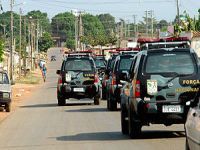Northeast Brazil: The most violent region in the world
The Mexican NGO Citizen Council for Public Security and Criminal Justice released a study listing the 50 most violent cities in the world in 2013, among those with more than 300 thousand inhabitants. 16 of them are Brazilian, nine in the Northeast, including eight capitals.

Fabricio Rebelo*
The figures are alarming, no other country had so many cities included in the listing. After Brazil, the second place was Mexico, with nine cities, an amount which corresponds only to Brazilian northeastern counties listed in the list.
Except for Teresina (PI), all capitals of the Northeast appear on the list of world's highest rates of murder, and the state of Paraíba, João Pessoa beyond the capital, had also included the city of Campina Grande. The worst performance in the country was the capital of Alagoas, Maceió, with a homicide rate of 79.76 per 100 inhabitants, followed very closely by Fortaleza (CE), with 72.81 per 100 thousand.
The crime in the Northeast is now a chronic problem. The average for the region, as indicated by the data collected in the Mexican study (54.6/100 000), is more than twice the national average - around 26/100 thousand, according to the latest edition of the Yearbook of the Brazilian Forum Public Safety . Sad reality.
As in any other region, understanding the causes of the northeastern crime is complex. However, upon the analysis of the regional phenomenon, some clear factors emerge as contributing to the establishment of the current framework.
The first and most obvious is the robust expansion related to drug trafficking, those engaging in such having settled in the region quickly and with little resistance. Just over a decade ago, drug trafficking gangs were almost exclusively in the Southeast region of the country. With the strong repression that they began to suffer there, especially with the policies of pacification in Rio de Janeiro and dismantling of organizations in São Paulo, the criminals were forced to migrate to other states, initially fleeing. And the destination was the Northeastern cities.
Without a history of effectively combating trafficking, the states of the region were truly invaded and dominated , increasing their casualties, because where traffic settles death multiplies. Today, studies of the secretaries of state for public safety indicate that over 60% of the homicides have a direct connection with drug trafficking.
The second factor that is evident is the use of a wrong strategy to combat violence. With the fame of a region of "gunmen", inherited from an already distant time in the Cangaço was his trademark, the Northeast served as a granary for what the federal government considered - or was said to consider - the solution to high homicide rates: civilian disarmament.
No other region of the country had so much investment in disarmament campaigns as the Northeast. And the data of the Ministry of Justice show that, in the collection of weapons, the adhesion was tremendous. In the first campaigns, Sergipe and Alagoas were the states with the greatest number of weapons surrendered, but that, as was once again shown, produced no effect on the number of homicides. The capitals of the two states now appear among the 50 most violent cities worldwide.
While investing in withdrawing from circulation potentially lethal weapons - the only ones covered by disarmament campaigns - trafficking expanded. It was a very "professional" organization being fought in a surprisingly amateurish way, to the extent that in some northeastern states, until very recently, it was not even officially admitted that gangs existed there. They attempted to gain salvation through denial.
Today, the issue cannot be ignored. Each study on the Northeastern situation seems to get worse and it is necessary to take urgent and effective measures to prevent chaos. Some measures, it is true, have already begun, but it is a game in which the reaction has only begun to be outlined with an already adverse score. The question is whether one can still reverse the situation, or if it will walk over towards the other unwanted title: that of owning the most dangerous region of the planet.
Considering the recent Northeastern history, together with its land area, population density and the geopolitical division, the title seems to be guaranteed.
* Fabricio Rebelo | degree in law, public security researcher, director and regional coordinator (NE) from NGO Movimento Viva Brazil .
Full study : http://www.seguridadjusticiaypaz.org.mx/biblioteca/finish/5-prensa/177-por-tercer-ano-consecutivo-san-pedro-sula-es-la-ciudad-mas-violenta-del-mundo/0
Subscribe to Pravda.Ru Telegram channel, Facebook, RSS!


